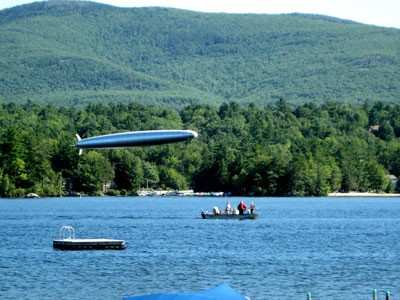Project Will Focus On The Use Of "Hyperblimps" To Silently
Study Right Whales
Paul Slusser from the University of Utah, and Daniel Geery,
president of Hyperblimp, LLC, both in Salt Lake City, Utah, have
been awarded a 2010 Lindbergh Grant in aviation and animal
conservation. The Lindbergh Foundation announced Thursday that the
grant was made for their project "Silently Recording the Behavior
of Endangered Right Whales Using Radio-Controlled Hyperblimp
Airships."

Hyperblimp LLC Photo
Since the 1970s, surveys have been made of southern right whales
by flying near the shores of Peninsula Valdes, Argentina, in a
light airplane, to observe and photo-identify individual whales,
record their locations and the presence of calves. As flight costs
have increased, aerial surveillance has decreased. Also, planes are
noisy and low altitude flying is risky. Although this population
has been recovering since the 1970s, more than 300 calves died
along Peninsula Valdes since 2005. The need to collect information
about this endangered species, and to better understand the causes
for the recent deaths, is vital to their long-term survival.
Mr. Slusser, Mr. Geery, and others plan to test a new design of
a radio-controlled blimp or airship with remotely operated,
gimbaled cameras. This design of airship can silently hover for
long periods, to observe, photograph and identify animals, causing
little disturbance.

Paul Slusser
Initial trials will be conducted in Utah, on animals such as
buffalo, antelope, and deer. The hyperblimp will then be used to
study right whales. Southern right whales are present May through
December, when researchers can document them, observe breeding
habits, behavior, and demographics. If recording is successful, the
next step will be collecting exhalation samples for evidence of
disease. Hyperblimps could reduce the cost of aerial surveillance
in Argentina by 90% and be of great use in studying other animal
species. Hyperblimp LLC intends to use these airships for other
environmental and humanitarian applications as well.
Slusser and Geery received one of eight Lindbergh grants awarded
so far this year. They were chosen from 166 applicants from around
the world. Lindbergh Grants are made in amounts up to $10,580, a
symbolic amount representing the cost of building Charles
Lindbergh's plane, the Spirit of St. Louis, in 1927. To date, more
$3 million has been awarded to 310 researchers.

Daniel Geery
The Lindgergh Foundation says its grants program maintains an
excellent reputation among the scientific community and the public
sector for supporting exceptional, high-quality projects and
dedicated researchers. The foundation says it subjects grant
applications to a rigorous five-step review process focused on
evaluations by two independent all volunteer review groups,
including a 48-member Technical Review Panel. This international
panel is comprised of knowledgeable and respected individuals drawn
from the various fields in which Lindbergh grants are made.
The annual deadline for all Lindbergh Grant applications is in
mid-June for funding the following year.
 Classic Aero-TV: In Praise of Alabamas Patriot Aircraft USA
Classic Aero-TV: In Praise of Alabamas Patriot Aircraft USA NTSB Final Report: Cirrus Design Corp SR22
NTSB Final Report: Cirrus Design Corp SR22 ANN's Daily Aero-Term (12.21.25): Dead Reckoning
ANN's Daily Aero-Term (12.21.25): Dead Reckoning ANN's Daily Aero-Linx (12.21.25)
ANN's Daily Aero-Linx (12.21.25) Aero-News: Quote of the Day (12.21.25)
Aero-News: Quote of the Day (12.21.25)





